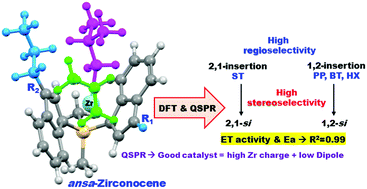Design and prediction of high potent ansa-zirconocene catalyst for olefin polymerizations: combined DFT calculations and QSPR approach†
Abstract
The homopolymerization of ethene (ET), propene (PP), 1-butene (BT), 1-hexene (HX), and styrene (ST) by the rac-[Zr{1-Me2Si(3-Pr-(η5-C9H5))(3-H-(η5-C9H5))Cl2}] ansa-zirconocene catalyst was investigated using Density Functional Theory (DFT) calculations. This study unveiled the following: (i) ansa-zirconocene is a regio- and stereoselective catalyst for PP, BT, HX, ST polymerization; (ii) the regio- and stereoselectivities depend on the orientation of the growing chain and the incoming olefin monomers; (iii) primary (1,2)-insertion is preferred over secondary (2,1)-insertion for linear olefins (PP, BT, and HX) while it is the opposite for ST; (iv) the activity of olefin polymerization by ansa-zirconocene is controlled by the thermodynamics of π-complex formation and the kinetics of insertion. Our results revealed that the regio- and stereoselectivity of the catalyst can be described by the steric interaction between the incoming monomer and the isobutyl group of the growing chain. For ET polymerization, the effect of the catalyst structure on the productivity of the process was examined and QSPR models were constructed based on experimental activities and theoretical calculations. The model suggests that potent ansa-zirconocene catalysts should have a lower dipole moment and a more positive charge on the Zr metal atom. This information will provide clues for the design of more potent ansa-zirconocene catalysts for ethylene polymerization.



 Please wait while we load your content...
Please wait while we load your content...